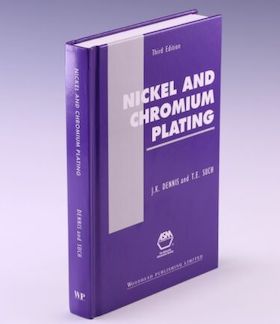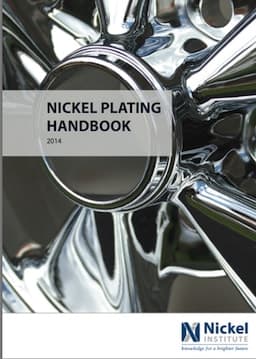
-----
Watts Nickel Plating Problem: pH is too high. Why? How to Fix?
Quickstart:
Various cations/cation radicals can be used for nickel plating, i,e,, the plating solution can be nickel chloride, nickel sulfate, nickel sulfamate, nickel fluoborate, etc. Each has advantages and disadvantages. The most commonly used nickel solution for decorative plating is Watts Nickel -- a solution of nickel sulfate, nickel chloride, and boric acid.
For Watts nickel plating to proceed properly the pH must be correct and the solution must be buffered with boric acid.
This thread addresses mostly the issue of the pH going too high. If your problem is the opposite, please see thread 238/67 "Watts Nickel Plating Problem: pH is too low. Why? How to Fix?"
![]()
(this entry appended to this thread by editor in lieu of spawning a duplicative thread)
Q. If the pH of Nickel solution is ideal at 3.8 to 4.2 and if pH starts to rise, why use Boric acid to make it more acid, when Boric acid pH is 5.0 to 6.0? It seems that it would just make the pH score rise.
Restorer - Hooper, Utah
September 24, 2025
A. Hi Vern,
You're right, boric acid is not used to lower the pH (nor to raise it). Rather, it's a buffer which works within the magical (to me) boundary layer to, per my understanding, prevent the pH from rising right at that point & time when hydrogen is generated which might cause the nickel to precipitate out instead of plating out.
Dilute sulfuric acid is used to reduce the pH; occasionally, as explained by Gene Packman, hydrochloric acid may be more appropriate.
Luck & Regards,

Ted Mooney, P.E. RET
Striving to live Aloha
finishing.com - Pine Beach, New Jersey
Ted is available for instant help
or longer-term assistance.
⇩ Related postings, oldest first ⇩
Q. Too high pH (more than 5.0) in Watts Nickel plating bath! I have problem with pH in Ni bath. To bring down I use sulfuric acid, but I am sure how to calculate additions.

Benigna Skorobogatiene
electrical components mfgr. - San Jose, California
2001
A. I would keep pH probe in bath and a dosing pump which will add as soon as pH increases. Continuous dosing will control bath better. By the way how much pH are you maintaining? 5 is too high for Watts bath.
Payal Mag- Charlotte, North Carolina
A. Calculate additions?
The normal way is to add small amounts 1/4 ml/L mix well (four hours or so) then see what has happened.
There is the problem that the boric acid acts as a buffer so you will add acid and see little change.
Do not get tempted to go overboard with the amounts added.
Keep a notebook of what is being added and the effect so if it happens again you can make the equivalent of several additions at once. (If you do this once more do not go over board with the additions).

Martin Trigg-Hogarth
surface treatment shop - Stroud, Glos, England
A. Dear Beningna,
You can try this :
1) Take a liter of your sample solution (pH 5)
2) Add H2SO4 in small measured amount to, say, pH 4.5
3) Now interpolate this amount of H2SO4 added to your 1 liter samples solution to your actual bath volume. You would have the actual quantity of H2SO4 to be added to your bath to bring down pH to 4.5
4) Add in, say, 3 installments and constantly check your pH.
It works for me, good luck!
Regards,
SK Cheah- Malaysia
A. All of the previous answers are good guidance. I just wanted to point out that sometimes I suggest using dilute hydrochloric acid (reagent grade) instead of dilute sulfuric acid. The reason is that it is one way of maintaining the nickel chloride in the solution while lessening additions of nickel salts. Further, if sulphate is rising, it allows an alternative.
Gene Packmanprocess supplier - Great Neck, New York
Q. Sir,
We have a Watts nickel plating baths for fiber plating purpose. It is jigging process.
We are maintaining the pH at 2.2 - 2.7. To adjust the pH we are adding H2SO4 and HCl with the ratio 1:1.5%.
We are maintaining NiCl2 at 48-69 g/lts. But after adding HCl the NiCl2 is more than the required specification and it also increased the NiS04 g/lts. What should we do to avoid the situation? The bath is 5000 liters. We have 8 nickel plating baths containing the same liters.
Regards
- Hyderabad andhra pradesh, India
December 30, 2013
A. pH should be maintained at 3.9-4.5.
Use sulfuric acid to maintain the pH, not hydrochloric.
Too high chlorides have a detrimental effect on ductility and while adding hydrochloric acid you cause corrosion of the equipment

Sara Michaeli
Tel-Aviv-Yafo, Israel
A. Are you using bar anodes? What is the specification of your nickel anodes? Are you adding the acid directly over the anodes? Is the final pH within limits after you add the acid? Do you use anode bags? Do you have a lot of nickel precipitate on your anode bags above solution level until you add acid? What is the concentration of each of the sulfuric and hydrochloric acids before you mix them 1:1.5?
Best wishes,
- OKC, Oklahoma, USA
A. Hello Sastri,
The reason your Ni metal is too high is because of the addition of HCl. As Sarah mentioned, you should not be adding HCl. The bath make up contains a certain level of NiCl2. Nickel chloride is in the bath to facilitate proper anode corrosion. If the chloride level is too high, your anode dissolution rate increases, in turn the Ni metal concentration in the bath rises. I was never a big fan of adding concentrated acids to lower ph values, you tend to over shoot your target. I have had success in adding a 10-20% dilution. Good Luck!
process engineer - Malone, New York
A. Sastry, You should not use hydrochloric acid to reduce the pH of a Watts bath - always use sulfuric acid. Hydrochloric acid will induce stress in your deposits and is very corrosive to most metals; it also smells! Also, never use concentrated acids - I would suggest 10% strength. Whenever you add acid to the bath, do is slowly and make sure the bath is well agitated. I am not sure why you see increases in both nickel sulphate and chloride when you add hydrochloric acid, but the way I analysed a nickel bath was to find the total nickel content and then the total chloride - this gives you they nickel chloride content and the rest of the nickel is sulphate. If you regularly need to alter the pH, this could be because there is insufficient boric acid, I would use about 30-35 g/l, although higher levels aren't particularly detrimental

Trevor Crichton
R&D practical scientist
Chesham, Bucks, UK
Q. Hello, I have a question as to keeping my nickel tank balanced. To reduce pitting particularly. Do I raise pH with boric acid and lower with sulfuric? Having pitting problems, big pain. Do I cure pitting with boric acid? Also, should my nickel ph be 4? Thanks a bunch!
Chase kowalecki- FAIRMOUNT [Georgia]
January 12, 2022
A. The solubility of the boric acid is a function of temperature, about 6 oz/gal for 120 °F, if you have too much it falls out and causes pitting. Raise the pH with Nickel Carbonate and then filter. Lower the pH with sulfuric acid. Three possibilities with your pitting. (1) mentioned above if the boric acid is too high and falling out. (2) organic contamination which your should carbon treat with sulfur free activated carbon. (3) Metallic contamination which you should electrolytically (dummy) plate out at low current density.

Robert H Probert
Robert H Probert Technical Services
Garner, North Carolina

A. 1) pH 5.0 NICKEL BATH TOO HIGH, KEEP 3.8 TO 4.5
2) MAKE SURE UNPLATED PARTS ARE CLEAN
3) CHECK SURFACE TENSION, A

Popatbhai B. Patel
electroplating consultant - Roseville, Michigan
![]() Thank you Mr. Patel. It seems peculiar that a plating company I obtained the bath from would say the ph is supposed to be 6 to 7 which is unheard of in my study. I am plating in small 3 gallon buckets, yet I have the nickel dialed in good now ranging at 4. Thanks again.
Thank you Mr. Patel. It seems peculiar that a plating company I obtained the bath from would say the ph is supposed to be 6 to 7 which is unheard of in my study. I am plating in small 3 gallon buckets, yet I have the nickel dialed in good now ranging at 4. Thanks again.
- FAIRMOUNT [Georgia]
⇦ Tip: Readers want to learn from your situation;
so some readers skip abstract questions.
A. Trevor_Crichton: What difference does it make to add diluted instead of concentrated sulfuric acid?
POOJA LADhobbyist - irvine, California
May 5, 2022
A. Hi, Pooja Lad,
I believe Trevor wrote that because there are many organic additives in a Nickel Bath, such as brightener, leveler and wetter.
A concentrated acid is very reactive and might break some of these organic compounds, leaving its traces in the bath. Not only will they stop working as they should, but these traces may also cause some burning in your deposit.
Before knowing this I used to add concentrated acid and never had a problem -- preventive maintenance with active carbon filtering should avoid this -- but since we know what could happen, might as well avoid more problems and add diluted acid.
Regards,
Chemical Engineer - Nova Friburgo, Rio de Janeiro, Brasil
Q, A, or Comment on THIS thread -or- Start a NEW Thread


